Estimating and mapping forest biomass in northeast China using joint forest resources inventory and remote sensing data
Xinchuang Wang?Shidong Wang?Limin Dai
Introduction
Forest ecosystems form the largest reservoir of organic carbon on the Earth(Dixon et al.1994;Melillo et al.2002;Phillips et al.1998).They balance regional and global carbon budgets and mitigate global warming induced by the increase in atmospheric CO2(Woodwell et al.1978).Forest biomass is an important indicator of stored carbon and of potential carbon sequestration in terrestrial systems(Le Toan et al.2011).Accurate mapping of forests and accurate estimates of biomass were important for a better understanding of the activity of the terrestrial carbon cycle and better understanding will lead to more effective forest management(Liu et al.2006;Sun et al.2016;Liu et al.2014).
There are different methods of estimating forest biomass(West 2004).Field measurements are considered the most accurate but they are time consuming and labour intensive and cannot provide large-scale,continuous spatial distribution of biomass(Brown 2002).Other methods include the average biomass method(Woodwell et al.1978;Dixon et al.1994),the volume to biomass conversion method(Brown et al.1989;Fang et al.2001;Pan et al.2004;Smith et al.2003),and the remote sensing method(Boyd et al.1999;Lu et al.2004;Tan et al.2007;Yemshanov et al.2012).These methods have been used to estimate biomass at larger scales.The volume to biomass conversion method is widely used to estimate total regional biomass because it can utilize forest inventory(FRI)data(Fang et al.2001;Pan et al.2004;Wang et al.2017).The remote sensing approach can provide full coverage of a geographic area and show the properties and spatial variability of ecosystems at many scales(Prince and Goward 1995;Running et al.1994;Zheng et al.2004).
Research estimates of forest biomass,either at global or regional scales,vary greatly(Houghton et al.2001;Blackard et al.2008)for several reasons.First,different methods of estimation,coupled with uncertainty due to natural or human factors,lead to different results(Pan et al.2004;Zhang et al.2014;Ren et al.2016).Second,parameter values of biomass estimation models change with forest type,age,density,and site.Even for the same forest type,other parameters cannot be accurately set(Kramer 1982;Brown and Schroeder 1999).Forest biomass estimates are scale-dependent(Li and Lei 2010).A larger scale biomass estimate may be not suitable for use at smaller scale regions.The extent of any such discrepancies is dif ficult to estimate.
Maps of large-scale forest biomass may be generated from remote sensing data.Low-resolution spatial imagery and high-resolution temporal imagery,such as provided by MODIS and NOAA-AVHRR,have been used to estimate forest biomass for relatively large geographic areas(Tan et al.2007;Anaya et al.2009;Zhang and Kondragunta 2006;Gonza′lez-Alonso et al.2006).Accurate biomass maps,based on remote sensing data,may be created by analyzing the correlation between spectral information detected by remote sensing and directly observed forest biomass(Du et al.2014).It is dif ficult to establish this correlation because of the complexity of forest canopy characteristics and the uncertainties of remote sensing information such as data quality and re finement,the spatial resolution of data,and the saturation effects of data(Lu 2007).The normalized difference vegetation index(NDVI)is one of the most frequently used indices derived from remote sensing data.It is particularly useful for the estimation of biomass but has some drawbacks such as NDVI saturation which means that continued increases in forest biomass will not be re flected in the information derived from NDVI when forest canopy density is greater than 80%(Gonza′lez-Alonso et al.2006;Tan et al.2007).The accuracy and spatial resolution of forest biomass maps at large scales based on remote sensing can be improved.
This study used sampled biomass data and FRI and remote sensing data to estimate and map the forest biomass of three provinces in northeast China.The primary objectives were:to get a more accurate estimate of the total forest biomass;to produce more spatially detailed biomass maps of the study area;and,to analyze the spatial variations in regional forest biomass to provide a reference baseline for forest policy-making and management.
To achieve these objectives,total forest biomass of each county and province was estimated using FRI data and forest sample data.The flow chart for the estimation and mapping using FRI and remote sensing data is shown in Fig.1.The sample data was obtained from 1156 plots in 11 different types of forest.New models of forest volume to biomass conversion were created.The FRI data were fitted to the models and used to calculate total biomass.The estimated biomass density for each county,together with SPOT-Vegetation(SPOT-VGT)NDVI data,were then used to develop a remote sensing-based model which provided the spatial distribution of biomass.Finally,regional spatial variations in biomass were analyzed in terms of the model-produced spatial distribution together with digital elevation model(DEM)data in order to provide baseline reference data for forest policy-making and management.
Materials and methods
Study area
The study area(38°43′–53°23′N and 118°50′–135°05′E)is in northeast China within Heilongjiang,Jilin and Liaoning provinces and covers an area of 78.7×104km2.The region is in fluenced by the high latitude East Asia monsoon and from south to north has warm temperate,temperate,and cold temperate climates.Average annual temperatures range from 11.5 to 4.8°C.Different temperature zones are de fined by average annual temperatures or average temperatures of the hottest mouth.Average annual temperatures range from 13 to 20 °C and 2 to 8 °C in warm temperate and temperate zone,respectively.Average annual temperatures are less than 0°C while Average temperatures of the hottest month are higher than 10°C in cold temperate zone.The Changbai,Xiaoxing’an,and Daxing’an mountains,as well as the Sanjiang,Liaohe,and Songhua river plains,are within the region(Fig.2).
Northeast China is one of the most densely-forested regions in China.Its land area is 8.2%of the country’s total but its forest area and reserves account for 20.9 and 19.6%,respectively,of China’s totals.The region is an important area of commercial forests and a source for various forest products.It is also the most important natural forest area and forms 80.3%of the region’s forested area and accounts for 89.5%of its forest volume.Tree species include:Dahurian larch(Larix gmeliniiRupr.)and Asian white birch(Betula platyphyllaL.)in the northern Daxingan Mountains;Korean pine(Pinus koraiensisSiebold and Zuccarini),amur linden(Tilia amurensisRupr.),and Korean birch(Betula costataTrautv.)in the Xiaoxingan Mountains area;Korean pine(P.koraiensisSiebold and Zuccarini),Manchurian fir(Abies holophyllaMaxim.),and Siberian elm(Ulmus pumilaL.)in the Changbai Mountains area;and Mongolian oak(Quercus mongolicaFisch.ex Ledeb.),and other deciduous species in the southern region(Fig.2).
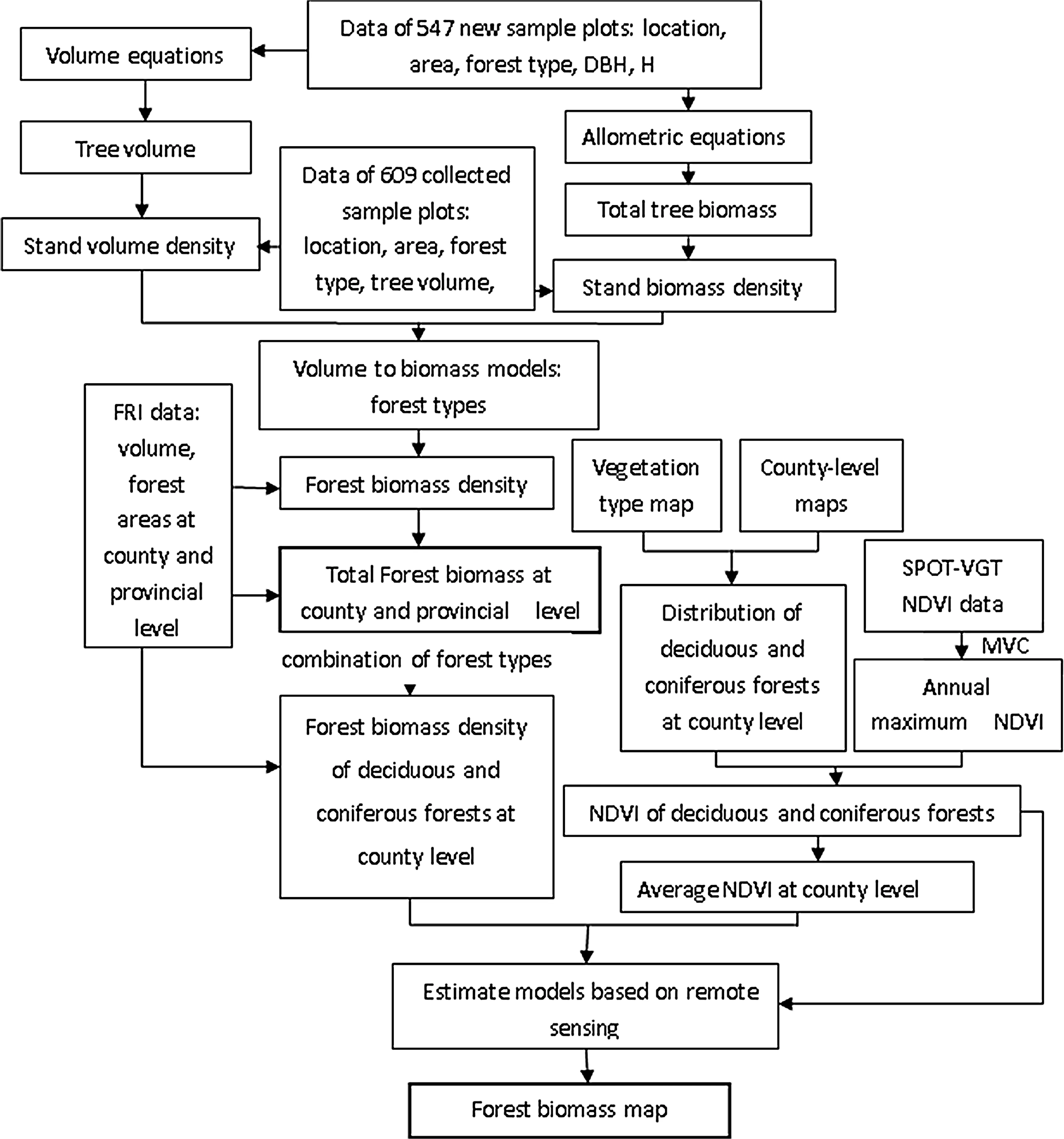
Fig.1 The flow chart for estimating and mapping forest biomass using joint FRI and remote sensing data
Data
Forest resource inventory data
Forest resource inventory(FRI)data were obtained from two sources:the 2006 forest management planning and design inventory(FMPDI)for Liaoning and Jilin provinces published by the Forestry Department of Liaoning Province,and the national continuous forest resource inventory(NCFRI)for Heilongjiang province(2004–2008),published by the Chinese Ministry of Forestry.With the FMPDI data,areas and volumes of various age groups of different forest types were recorded by county.In the NCFRI data,forest area and timber volumes were provided for each major forest type by province.
FRI data usually include estimates of timber volume(wood typically harvested for commercial products),and lack information about non-commercial components(roots,branches and foliage)that should be included to calculate total forest biomass.
Biomass plot data and tree allometric equations
In total,1156 plots which consisted of 609 plots sampled by Xu et al.(2007)and Chen(2003)and 547 new plots sampled in this study were used to stratify biomass data by field sampling.Data for each of the 609 plots included plot number,location,geographical position(latitude,longitude and elevation),forest of origin,dominant species,number of species,average specimen age,average specimen density,and biomass and volume per unit area.In order to estimate the biomass of each tree,333 tree allometric equations from Luo(1996)together with tree allometric equations from theNortheast Forest Biomass Handbook(Chen and Guo 1986)were used.In order to estimate volumes in a sample area,we used models provided by the relevant forestry management departments.
Vegetation types

Fig.2 Location of the study area
Data for the distribution of different forest types were obtained from theVegetation Atlas of China(EBVMC 2001)at a scale of 1:1,000,000.The Atlas contains data for 573 vegetation types and 75 forest types mainly obtained from ground observations.The China Earth Science Data Sharing Network Center provided digital data sets relevant to the study area.In order to facilitate the quanti fication of the biomass contributions of various forest types,all forest types were reduced to two:deciduous needle-leaf forests dominated byL.gmelinii;and,broadleaf forests dominated byQ.mongolicaandB.platyphylla.
NDVI data
The normalized difference vegetation index(NDVI)is the ratio of the difference between visible red re flectance and near infrared re flectance to the sum of the two quantities.It is used as an index to predict the amount and the state of vegetation cover and the changes of the vegetation(Myneni et al.1995).The NDVI data in this study are from the 2006 SPOT Vegetation NDVI data set pre-processed and released by the Flemish Institute forTechnological Research(VITO)VEGETATION Image Processing Center(CTIV).The VGT-S10 product provides a 10-day maximally-corrected,synthesized 1-km resolution NDVI data set.The set is created by processing the raw data through a series of geometric,radiometric and atmospheric corrections and then compositing the corrected data using multiband synthesis and maximized synthesis techniques.A maximum value composite procedure(MVC)was used to further reduce the residual atmospheric and bidirectional effects to produce the annual maximum NDVI data set(Holben 1986).
DEM data
The digital elevation model(DEM)data used in this study were from the Shuttle Radar Topography Mission(SRTM)digital elevation database,jointly produced by NASA and theUSGS NationalImageryandMappingAgency(NIMA).This database was first publicly released in 2003 and has been revised several times.The current database is version 4.1.The DEM data in this study area were downloaded from the International Scienti fic&Technical Data Mirror Site,Computer Network Information Center,Chinese Academy of Sciences.
Methods
Sample plot survey and data pre-processing
Lack of suf ficient,high quality sample plots is a major barrier to the development of robust biomass estimates and their validation(Wulder et al.2008).We selected the following areas in which to locate sample plots:Huzhong Forestry Bureau,Maoershan Forest Field,and Lianshui National Nature Reserve in the Dailing district of Heilongjiang province;Loushuihe Forestry Bureau in Jilin province;and,Caohekou Forest Field and Daqinggou National Nature Reserve in Liaoning province.These areas were selected because they are typical of the region in terms of climatic and geographic factors(Fig.2).
Field surveys were carried out from July to September from 2007 to 2010.Sample plots were identi fied as well as tree layers of the various forest types.Sample plot quadrants 20×20 m were randomly selected and height and diameter at breast height(DBH)>2.0 cm were measured.In total,547 new sample plots were created.
DBH values were substituted into the corresponding allometric equations for the species as shown in Eq.1.Tree biomass of the sample plot was estimated which was used to calculate biomass per unit area(Eq.2).
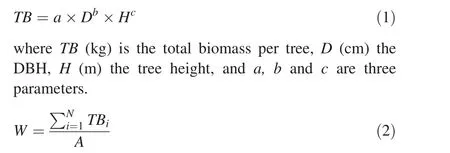
whereW(Mg ha-1)is the biomass per unit plot area,TBi(Mg)the biomass per tree,Nthe number of trees with DBH>2 cm,andA(ha)the area of the plot.
The DBHs and heights were substituted into the volume equations(Eq.3)of the corresponding species to estimate the volume of each tree in the plot and then used to calculate the tree volume per unit area.

whereTV(m3)is the total tree volume,D(cm)the DBH,H(m)the height,anda,bandcare three parameters of volume equations.
Establishment of volume to biomass conversion models and estimation of biomass based on the models
The volume to biomass conversion method,also called the biomass conversion factor method,is the most efficient and reliable method for the estimation of the biomass of a forest ecosystem(Fang et al.1998;Li and Lei 2010).The biomass is calculated by multiplying the average biomass per unit volume by the total volume of the forest type(Li and Lei 2010).Volume to biomass conversion methods include those identi fied in the IPCC guidelines as well as the biomass conversion factor continuous function method(which combines biomass data with national FRI data)and empirical models for biomass estimation.The method we used to estimate regional biomass combines data from an empirical survey of tree volume and biomass with data from the National Forest Resources Survey.This provides us with reliable observed volume and biomass data for different forest types as well as comprehensive forest resource data on a regional or national scale.Thus,we can build an accurate volume to biomass conversion model.
We used data for 1156 plots(609 plots from the work of other researchers and 547 plots surveyed as part of this study).We categorized the data into 11 forest types.The spatial distribution of the plots is shown in Fig.3.The biomass to volume regression model for each of the different forest types was established through regression analysis(Eq.4).

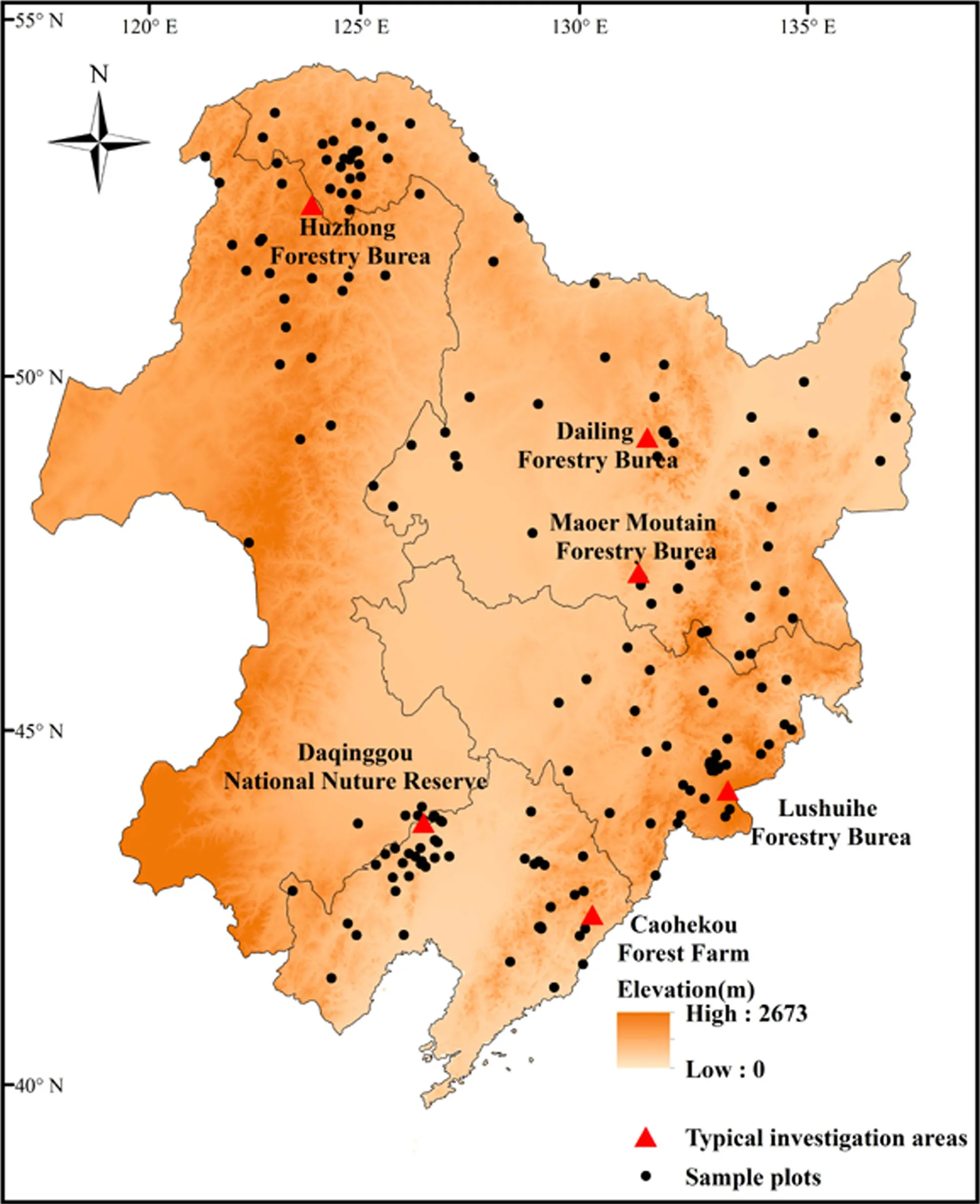
Fig.3 Distribution of typical survey areas and forest sampling plots in northeast China
whereWi(Mg ha-1)is the biomass density of the forest typei,Vi(m3ha-1)the volume per unit area of the forest typei,andaandbare two parameters.The root mean square error(RMSE)was calculated in order to measure the difference between observed and predicted biomass density.Table 1 shows the volume(V)to biomass(W)regression models and the RMSE for the 11 forest types in the 1156 sample plots.
Finally,the total forest biomass of each plot was calculated usingWicombined with the FRI data(for Heilongjiang province)and FPDI data(for every city and county in Liaoning and Jilin provinces),as shown in Eq.5.

whereCt(Mg)is the total biomass of forest typeifor the county or province,Wi(Mg ha-1)the biomass per unit area of forest typeifor the same region,andAi(ha)the area of forest typeiin the same region.
Combination of forest types
The forests in Liaoning,Jilin and Heilongjiang provinces were classi fied into 23,24,and 23 types respectively in the FRI data.We aggregated the data into 11 forest types based on their similarity to the dominant species(Table 2)to estimate biomass using the volume to biomass conversion model described above.

Table 1 Parameters to calculate forest biomass density(W,Mg ha-1)and their root mean square errors(RMSE),Biomass density is expressed as a function of stand growing volume(V,m3ha-1),W=aV+b,where a(Mg m-3)and b(Mg ha-1)are parameters for a forest type
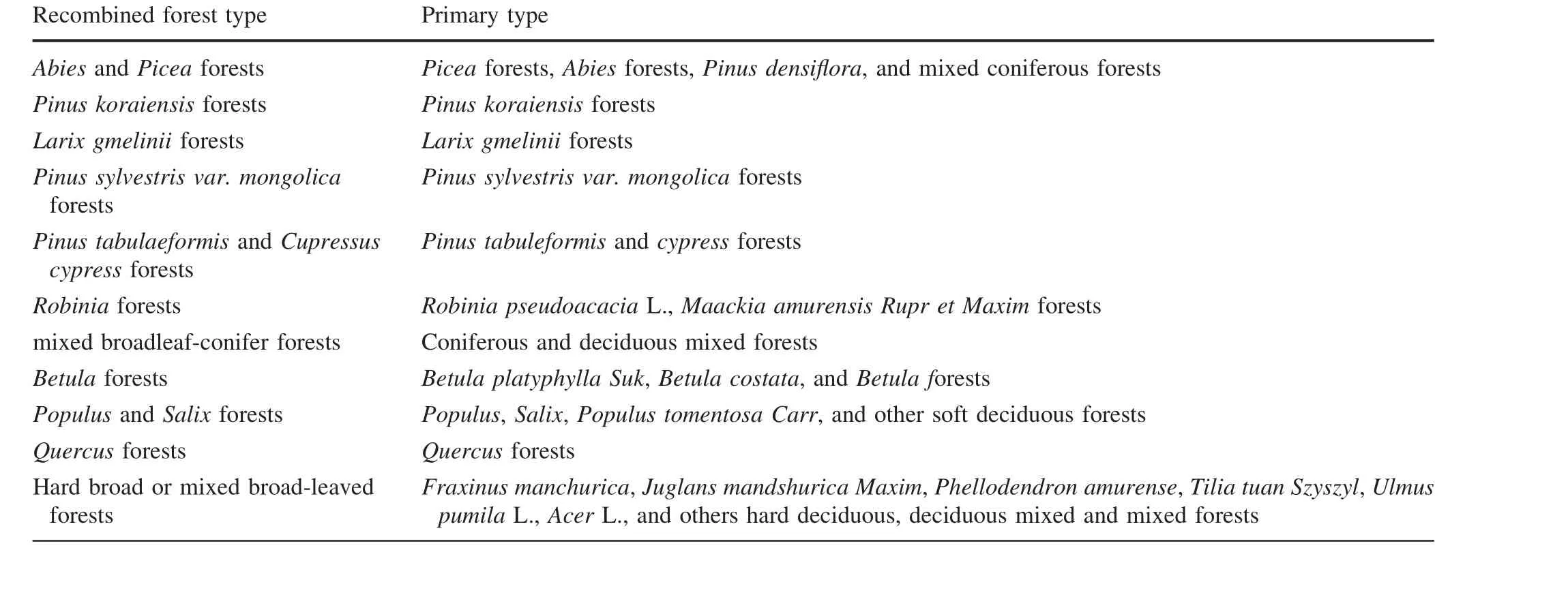
Table 2 Eleven recombined forest types in the northeast China’s provinces
Mapping forest biomass using remote sensing
According to Tan et al.(2007),there is a signi ficant correlation between the annual maximum NDVI(NDVImax)and biomass estimated from FRI data.Accordingly,we used the vegetation distribution map and SPOT VGT NDVI data to map the higher-resolution spatial distribution of forest biomass.
The following procedure to map forest biomass was used.First,based on the estimates of biomass,the forest types of the various counties in Jilin and Liaoning provinces were aggregated into either coniferous forests or deciduous broadleaf forests(any mixed forests were classi fied as coniferous).Their areas,biomass and biomass densities were recalculated.Second,using ArcGIS 9.3,we obtained forest distribution data at the county level by overlaying the forest vegetation distribution maps and the county-level maps of Jilin and Liaoning provinces.The average areas of the forests and the values ofNDVImaxwere calculated in each region.Third,the calculated forest areas and forest areas derived from FRI data were compared.We selected those counties that showed differences in forest areas between the two data sets.The vegetation map was not created at the same time as the FRI data were collected hence there were inconsistencies between the map and the FRI data.Fourth,we extracted the areas of coniferous and deciduous forests from the selected counties and interpolated the averageNDVImaxfor each type.Fifth,the relationship between averageNDVImaxand biomass density for each forest type was calculated.We selected the data of 28 counties and cities where there was a greater area of deciduous broadleaf forests and the data of 18 counties and cities where there was a greater area of coniferous forests.The data was used to create remote sensing models of deciduous broadleaf and coniferous forests.Sixth,we used SPSS to create regression models by selecting the best model according to the coefficient of determination,residual value,andPvalue.Finally,the selected model simulated the biomass density of each forest type and generated a map of forest density in the study area.The models for biomass density estimates are Eqs.6 and 7.
For the deciduous broadleaf forests:

withR2=0.717,RMSE=7.178 Mg ha-1, andP=9.44×10-6whereBkandBz(Mg ha-1)are the pixel biomass densities of deciduous broadleaf and coniferous forests,respectively,andDNis the gray pixel value of SPOT VGTNDVImax.
Analysis of DEM-based forest biomass spatial characteristics
ArcGIS 9.3 was used to generate slope and aspect maps of the study area using the DEM data.According to the geomorphological characteristics of northeast China,the elevation was divided into four levels:<300,300–500,500–1000 and>1000 m.There were four classes of slope:steep ≥ 26°;moderate 16°–26°;gentle 6°–16°;and flat 0°–6°according to national standards and the characteristics of slopes in northeast China.There were five aspects:shady slope(N,NE),semi-shady slope(E,NW),sunny slope(S,SW),semi-sunny slope(W,SE),and flat—using the magnetic azimuth.ArcGIS 9.3 was used to analyse the characteristics of forest biomass at different elevations,slopes,and aspects.

?
Results
Biomass and density characteristics of different forest types and age groups
Table 3 shows the estimated biomass for different forest types and ages in the study area using the parameters of the forest volume to biomass conversion model(Table 1)and the FRI data.Table 3 further illustrates that the total forest biomassin the study area was2440.8±313.9 Tg(1 Tg=1012g).The biomass of different forest types were between 16.1 and 914.7 Tg.The biomass of each forest type is directly related to its area.Of all forest types in the study area,the mixed broadleaf forests,Q.Mongolicaforests,L.gmeliniiforests,andB.platyphyllaforests accounted for 37.5,16.8,13.8 and 9.7%of the total biomass,respectively.The same forest types accounted for 35.2,15.6,15.0,and 11.0%of the total forest area,respectively.Middle-aged and young forests accounted for 39.9%and 30.0%of the total forest area and 42.0 and 15.7%of the total forest biomass,respectively.
Biomass densities of the forest types varied between 47.6 and 93.1 Mg ha-1, with an average of 77.2±9.9 Mg ha-1.Biomass density was related to the forest type and age and was the greatest in mixed broadleaf-conifer forests.The total areas of near-mature,mature,and over-mature mixed broadleaf-conifer forests accounted for 32.0%of the total area.Biomass density ofP.tabulaeformisforest was the least.The total area of near-mature,mature and over-matureP.tabulaeformisforest accounted for 27.0%of the total area.Biomass densities of all forests varied with age.Ranges of the biomass densities for young,middle-aged,near-mature,mature and overmature forests were 32.6–62.6,50.6–111.9,63.5–144.6,69.6–213.2,and 78.4–178.6 Mg ha-1,respectively.Overmature forestshowed the greatestbiomassdensity(113.3 Mg ha-1),which was 2.8 times the least biomass density of young forest(40.5 Mg ha-1).
Comparison of estimated biomass based on remote sensing and volume to biomass conversion models
Figure 4b shows the spatial distribution of biomass density as estimated by Eqs.6 and 7 using vegetation type and SPOT VGT NDVI data.Biomass and biomass density of the three provinces were calculated from the map of biomass density(Table 4)and shows that the estimated total biomass densities of Jilin and Liaoning provinces were almost equal but that the estimated total biomass density of Heilongjiang province was very different.To verify the accuracy of the results from the remote sensing method on a smaller scale,35 counties with greater forest areas were selected to estimate their biomass densities using the two schemes.Figure 5 shows the correlations obtained by the analysis.
The estimations obtained using the remote sensing method show the spatial distribution of biomass density and can be used to further analyse the spatial distribution of forest biomass.
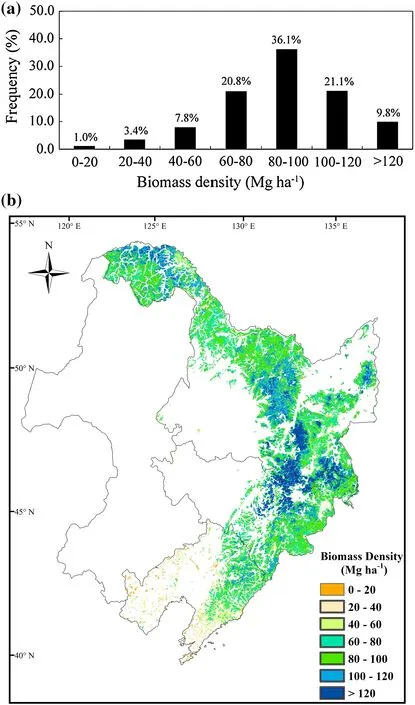
Fig.4 Frequency distribution(a)and spatial distribution(b)of forest biomass density in the study area
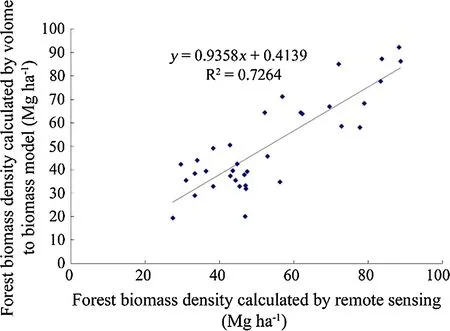
Fig.5 Correlation relationship of estimated forest biomass of 35 counties/cities in the study area based on remote sensing and volume to biomass models

?
Spatial differentiation of biomass and biomass density
Horizontal distribution and statistical characteristics
Biomass density in the study area increased from north to south,and then decreased from north to south.Regions with the greatest biomass density(>120 Mg ha-1)were mainly in the centre of the study area while regions with the least biomass density(<40 Mg ha-1)were mainly in the south as shown in Fig.4b.
The histogram of biomass densities in northeast China showed that most forests were in the range 80–120 Mg ha-1.Biomass densities of 28.6%of the forests were 40–80 Mg ha-1(Fig.4a).Areas with biomass densities less than 10 Mg ha-1and those greater than 120 Mg ha-1were very small,accounting for 4.4 and 9.8%of the total forest area,respectively.
Vertical distribution characteristics
Table 5 shows biomass and biomass densities at different elevations,slopes and aspects.Biomass was mainly distributed in areas of 300–1000 m(74.3%of the total biomass);the remaining was on the plains below 300 m(22.0%),and in the mountains above 1000 m(3.7%).Biomass at different elevations is related to forested area at different elevations.Forests at 300–1000 m have the largest distributional area(70.9%of the total area).Forests at elevations<300 and>1000 m account for 25.8 and 3.3%of the total forest area,respectively.
Biomass increased with forest area and density varied significantly with elevation,increasing as elevation increased.Biomass densities at 500–1000 and>1000 m were 11.3 and 10.5%more than biomass densities at 300–500 m.Biomass density at 300–500 m was 16.4%greater than biomass density at<300 m elevation.
Slope distribution characteristics
Biomass was mainly distributed on flat and gentle slopes(Table 5).Biomass on different slopes were in the order of flat>gentle>moderate>steep,accounting for47.0,40.7,11.1 and 1.2%of forest biomass,respectively.This result is related to the distribution of forests on different slopes.Forest areas by slope were flat>gentle>moderate>steep,accounting for 50.0,38.8,10.2,and 1.1%of the total area,respectively.
Changes in average forestbiomass density first increased and then decreased with slopes increasing(Table 5).In other words,the average biomass of forests on the flats(0%slope)was significantly less than the average biomass on other slopes.
Aspect distribution characteristics
There was little difference in forest biomass between semishady,sunny,semi-sunny and shady slopes.However,the biomass and biomass densities of forests on these aspects were significantly greater than for forests on flat areas(Table 5).
Discussion
Effect of volume-to-biomass conversion models on estimated biomass at different scales
The number of sample plots and the classi fication of forest types used to establish the forest biomass conversion model affected the accuracy of the estimates of regional forest biomass.At the national scale,Fang et al.(2001)created a volume-to-biomass conversion model that used the conversion factor continuous function method with data from published literature to estimate China’s forest biomass and carbon storage.However,their model did not fully consider the effect of forest age on the relationship between forest volume and biomass,and the number of plots used for analysis was inadequate(Zhao and Zhou 2004).Pan et al.(2004)used the data obtained from 5415 plots to estimate the biomass of different types of forests of different age groups.Pan et al.(2004)compared their results with those of Fang et al.(2001)and found that the model may have overestimated forest biomass by 21%.Fang et al.(2001)’s study had been considered accurate in its estimation of China’s forest biomass.We used Pan et al.’s(2004)model and the FRI data to estimate biomass of the different forest types in the three provinces in the study area.Table 6 shows that the biomass estimates of the two models differed greatly.For Liaoning province,the results were close,differing by only 0.5 Tg,while for Jilin and Heilongjiang provinces,the biomass varied by up to 123.9 and 166.3 Tg,respectively.In general,the estimates given by Pan et al.’s(2004)model were 16.4%greater than those of this study.
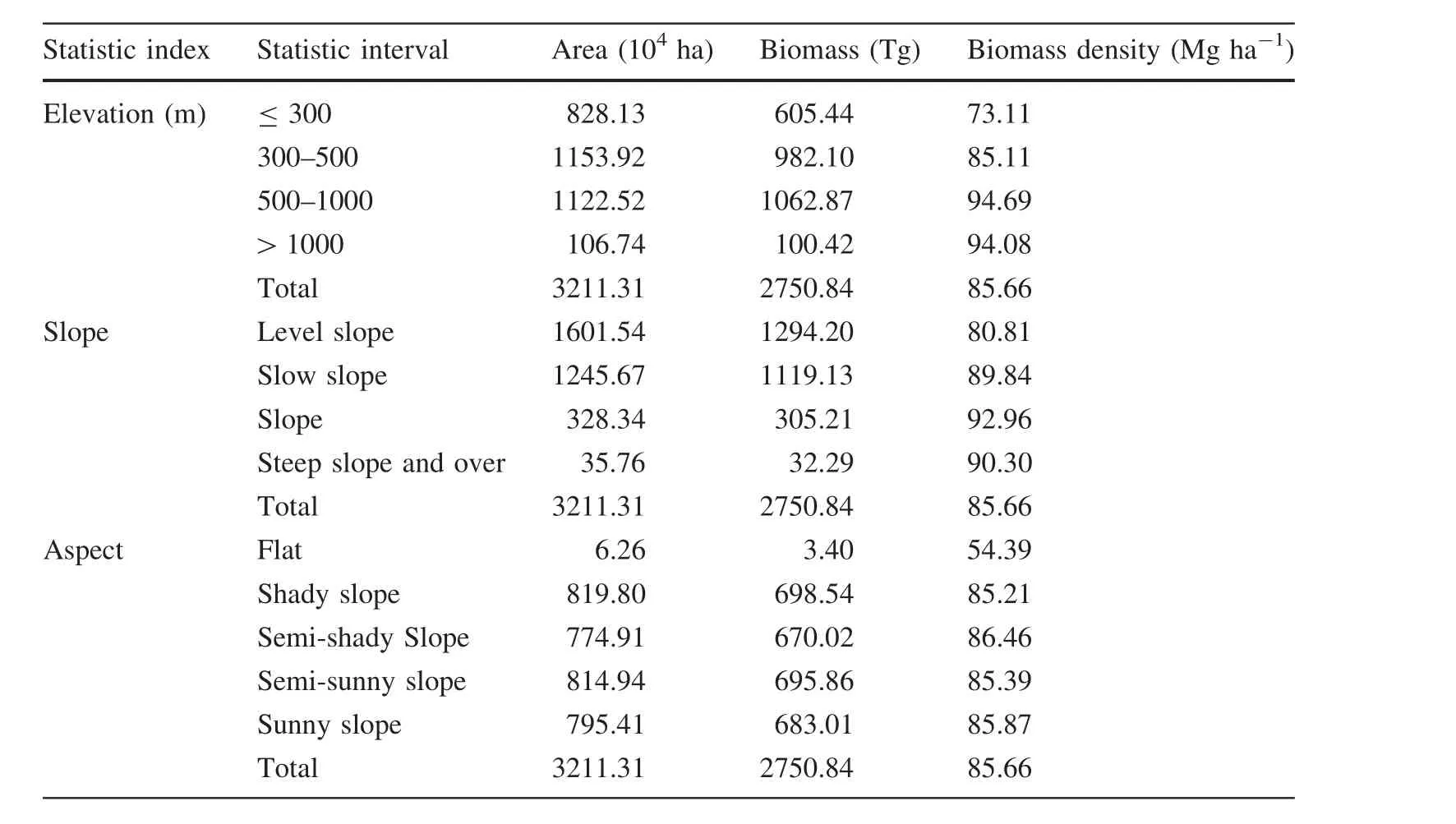
Table 5 Biomass and biomass density characteristics of forests at different elevations,slopes and aspects in the study area

Table 6 Estimated results of forest biomass and density in the three province of the study area by the volume to biomass models of this study and Pan et al.(2004)
China is a vast territory.The climate ranges from tropical to cool temperate in which many types of forest grow.A volume-to-biomass conversion model that works well at the national scale may not work well on a regional scale.Previous studies have shown that limited numbers of sample plots and restrictions in the numbers of forest types can reduce the ef ficacy of a model that may be accurate on a small scale if it is used on a larger scale to estimate biomass and carbon reserves(Botkin and Simpson 1990;Wulder et al.2008).To counter this limitation,we surveyed 547 plots in six selected typical regions and collected published data from 609 plots in the study area and its surrounds.We partitioned the data into 11 forest types and created the volume-to-biomass conversion model for the study area.The locations,vegetation types,and characteristics of the surveyed plots were all typical for the vegetation of northeast China,and the forest type classi fication used matches the main forest types of northeast China.In contrast,in the model built by Pan et al.(2004),only seven types of forests matched those in northeast China and the number of plots used was much lower than the number of plots used in this study.Thus the model developed in this study may be considered to be a better fit for northeast China.
The preceding analysis shows that the scale of the model has a great effect on the estimation of biomass.A model on a national scale may not be suitable for regional or local applications,and thus the creation of a regional volume-to–biomass conversion model is necessary for accurate estimation of regional forest biomass.In order to accurately estimate carbon storage and carbon cycle activity in a regional or global forest ecosystem,a scale-speci fic model is required.
Comparison with previous biomass estimations
Li and Lei(2010)used data from theNational Forest Resources Statistics(2004–2008)7th NFIto produce a set of biomass estimates for forests in Jilin province using various models.The models included the continuous function of biomass conversion factor proposed by Fang et al.(2001),the empirical model for biomass estimation,the IPCC variable biomass expansion factor,and the IPCC fixed biomass conversion factor.Jiao and Hu(2005)used FRI data from the 1st NFI(1973–1976)though the 6th NFI(1999–2003),and assumed a linear relationship between the biomass of a tree and its volume in order to estimate and analyze the carbon storage of various species in Heilongjiang Province over a recent 30-year period.Wang et al.(2008)used FRI data from the 3rd NFI(1984–1988)through the 6th NFI(1999–2003)to create a biomass–volume model based on dominant tree species in Liaoning province.
Table 7 shows forest biomass and densities given by different models in three provinces of northeast China.Our results,using the empirical model,are roughly consistent with the biomass and density estimated by Li and Lei(2010).Their biomass estimate is 2.3%lower than ours and their density estimate 11.7%higher.The results obtained by Wang et al.(2008),using the mixed method to estimate biomass and biomass density in Liaoning province,differed from our results,being lower by 29.9 and 45.4%,respectively.These differences could be caused by different estimation methods and their use of FRI data from a different period.Excluding the results from Liaoning province,the results of our study are close to the estimates obtained by Li and Lei(2010)using the IPCC variable biomass expansion factor method.However,biomass and density estimates for Jilin province obtained by Li and Lei(2010)using the IPCC fixed expansion factor method,the empirical model for biomass estimation,and the conversion factor continuous function method were 50.0,47.2 and 39.2%higher than ours,respectively.Our estimates for Helongjiang province were close to those of Jiao and Hu(2005)but differed greatly from those of Li and Lei(2010)which were 10.6%lower than ours.Overall,the total biomass and average biomass density given by Li and Lei(2010)using the empirical model were 29.1 and 27.4%higher than ours,respectively.
The preceding analysis shows that there are large differences between the estimates of forest biomass provided by differentmodels.Large-scale biomassestimation models may not be suitable for smaller scale biomass estimates.The effects of differences in scale on the accuracy of forest biomass estimates are obvious.Thus,it is important to develop and establish an accurate small-scale biomass estimation model and to move incrementally from small-scale to larger scale estimation in order to accurately estimate forest biomass at national and global scales.
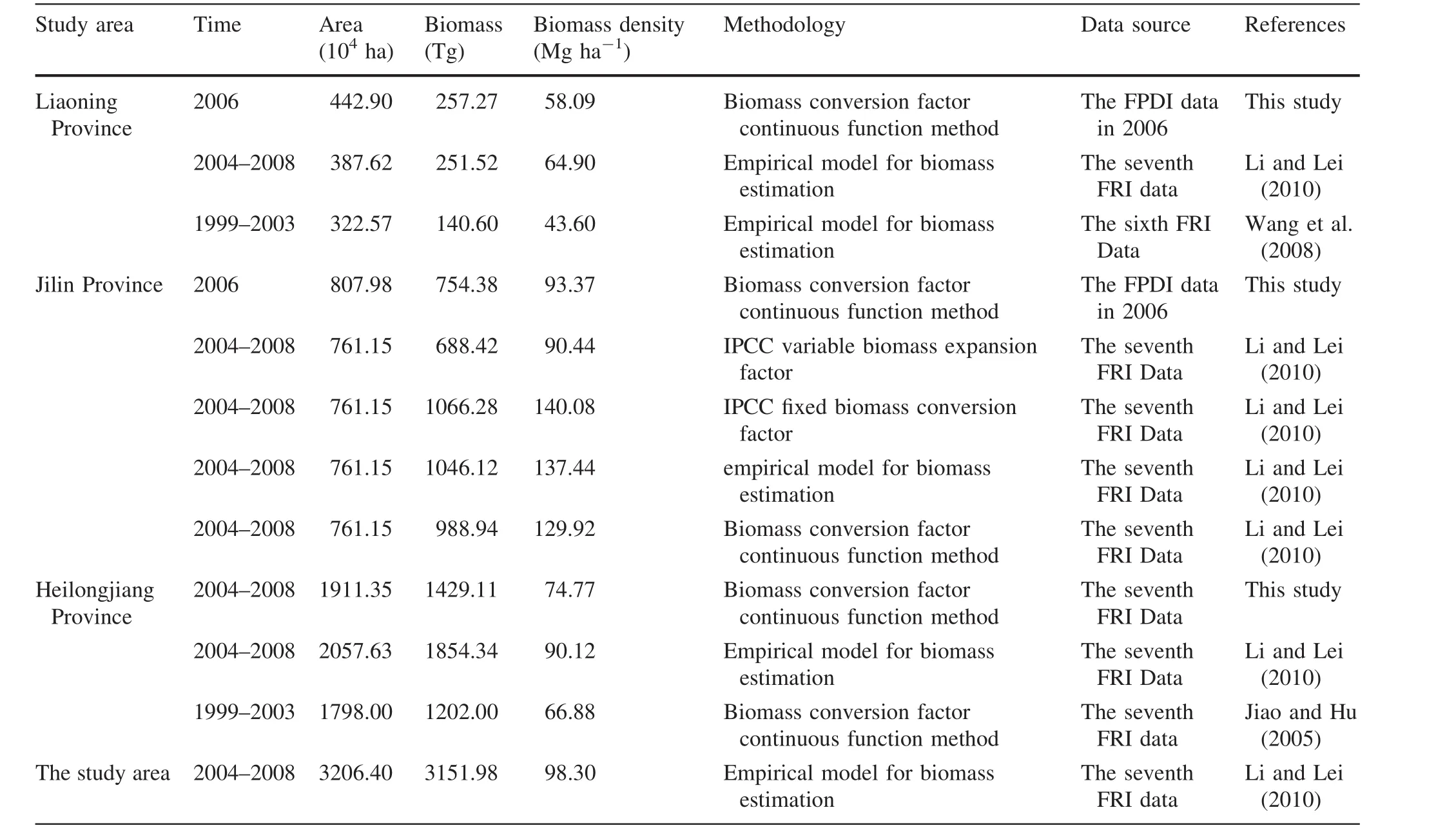
Table 7 Comparison of different forest biomass and density estimation results with previous biomass estimations
Impact of human activities on biomass density
In general,the spatial features of forest biomass density in the study area show that overall biomass density increases as the elevation increases, first increasing and then decreasing as the elevation increases.Biomass density on flat areas is significantly lower than on slopes.The reasons for this are not clear.
The signi ficant differences in forest biomass density at different elevations,slopes and aspect are related to human disturbance.Forests with low biomass are mostly secondary forests,young in age,and disturbed by human activity.On the plain areas(elevation<300 m),forest plantations are mainly trees with low biomass and low biomass density.In contrast,forests growing at>500 m are mostly mixed deciduous and mixed coniferous–deciduous forests with greater biomass and higher biomass densities and have been less affected by human interference.Farming is common on the plains where forest vegetation is easily disturbed by human activity and leads to low carbon density.As slopes increase,farming is reduced and forest vegetation is less affected and results in higher carbon densities.On steep slopes,soil erosion seriously limits forest growth,which results in a decrease in biomass densities.With respect to biomass density differences in slope aspect, flat areas(i.e.no slope aspect)are often affected by human activities which results in lower forest biomass density.
Human activity is extremely in fluential in the decrease in regional forest biomass density in northeast China and leads to spatial differences in forest biomass.In other words,only by reducing human activity and by strengthening forest protection and reconstructing degraded forest ecosystems,in conjunction with the current Natural Forest Resources Protection Project and the Returning Farmland to Forest and Grassland Project in northeast China,can carbon sequestration in regional forests be significantly increased.
Uncertainties in mapping forest biomass based on remote sensing
We recognize that some uncertainties can lead to inaccuracies in forest biomass maps created in this study.Many factors can in fluence accuracy,such as the quality of remote sensing data,correction and compositing of the empirical data,and the spatial resolution and the saturation effect of remote sensing data(Lu 2007;Tan et al.2007).The SPOT-VGT NDVI dataset was used to produce the annual maximum NDVI data for forest biomass estimation by MVC.The effects of atmosphere and cloud may be compensated for to some degree but will still have some in fluence on the SPOT-VGT data set.
In this study,the models of deciduous broadleaf and coniferousforestswere establishedby regressionanalysisof theaveragebiomassdensityandNDVImaxofforestedareasin counties having similar or greater forested areas in the vegetationmapthanfoundintheFRIdata.TheR2andRMSEof ourmodelswerebetterthanthoseofTanetal.(2007),which wereR2=0.56,RSME=13.98 Mg C ha-1.The better results of our model may be due to the relatively high spatial resolution of data we used(1 km compared to 8 km in Tan et al.2007),as well as the data optimized in creating the model,and the separation of models for different forest types.Although the spatial resolution of SPOT-VGT NDVI(1 km)was finerthanthatofNOAA/AVHRRNDVI(8 km),it is still coarse for forest biomass mapping.Mixed pixels abound in the SPOT-VGT NDVI dataset,which leads to dif ficulties in the identi fication of the precise range and spectral information for a forested area and subsequent uncertainty in mapping the biomass.
Remote sensing is more sensitive to crown surfaces than below-canopy factors.When canopy density is greater than 80%,increases in forest biomass will not be shown in the information derived from remote sensing(Tucker and Sellers 1986).Tan et al.(2007)suggested that NDVI saturation may cause the biomass density to be underestimated in a region with dense canopy cover,such as in the Changbai Mountains.In this study,we used the average biomass density andNDVImaxof the forested area at a county level to create models to estimate forest biomass.The comparisons of biomass based on remote sensing and estimates from volume to biomass conversion models showed that the maps could re flect the spatial distribution of biomass density at the county level.It is still very hard to test the accuracy of the biomass estimate at the pixel level(1 km).If plot level biomass estimates at this scale are available in the future,validation will be possible(Du et al.2014).
Conclusion
We estimated regional forest biomass using both FRI data and plot survey data.Vegetation distribution data,remote sensing data,and DEM data were used to map the spatial distribution and forest characteristics. The main conclusions are:a large-scale biomass estimation model may not be suitable for smaller scale forest biomass estimation;the regional volume to biomass conversion model provides an accurate estimate of the regional forest biomass;and,the forest biomass in northeast China at different elevations,slopes,and aspects is greatly affected by human activity.Overall,the variations in both regional biomass and biomass density with respect to elevation and slope indicate that forest vegetation in northeast China is very vulnerable to interference from human activities.The only way to protect and stabilize the regional forest biomass is to reduce such activities.
AcknowledgementsThe authors thank all staff members in the Natural Forest Conservation Group(NFCG)of the Institute of Applied Ecology(IAE)for their help.We are grateful to the authors of Xu et al.(2007)and Chen(2003)who allowed us to use their data for the 609 plots.
References
Anaya JA,Chuvieco E,Palacios-Orueta A(2009)Above-ground biomass assessment in Colombia:a remote sensing approach.For Ecol Manag 257:1237–1246
Blackard JA,Finco MV,Helmer EH,Holden GR,Hoppus ML,Jacobs DM,Lister AJ,Moisen GG,Nelson MD,Riemann R,Ruefenacht B,Salajanu D,Weyermann DL,Winterberger KC,Brandeis TJ,Czaplewski RL,McRoberts RE,Patterson PL,Tymcio RP(2008)Mapping US forest biomass using nation wide forest inventory data and moderate resolution information.Remote Sens Environ 112:1658–1677
Botkin DB,Simpson LG(1990)Biomass of the North-American boreal forest:a step toward accurate global measures.Biogeochemistry 9:161–174
Boyd DS,Foody GM,Curran PJ(1999)The relationship between the biomass of Cameroonian tropical forest and radiation re flected in middle infrared wavelength.Int J Remote Sens 20(5):1017–1023
Brown S(2002)Measuring carbon in forests:current status and future challenges.Environ Pollut 116:363–372
Brown SL,Schroeder PE(1999)Spatial patterns of aboveground production and mortality of woody biomass for eastern U.S.forests.Ecol Appl 9:968–980
Brown SJ,Gillespie R,Lugo AE(1989)Biomass estimates for tropical moist forests of Brazilian Amazon.Interciencia 17:8–18
Chen XL(2003)The distribution patterns and modeling of biomass and net primary production in China main forests.Doctor of Philosophy Thesis,Beijing Forestry University,Beijing,China(in Chinese)
Chen CG,Guo XF(1986)Mathematical models for predicting broadleaved-Korean pine mixed forest biomass.J Liaoning For Sci Technol 3:27–37(in Chinese)
Dixon RK,Brown S,Houghton RA,Trexier MC,Winsniewski J(1994)Carbon pools and flux of global forest ecosystems.Science 263:185–190
Du L,Zhou T,Zou ZH,Zhao X,Huang KC,Wu H(2014)Mapping forest biomass using remote sensing and national forest inventory in China.Forests 5:1267–1283
EBVMC(Editorial Board of Vegetation Map of China,Chinese Academy of Sciences)(2001)Vegetation Atlas of China.Science Press,Beijing(in Chinese)
Fang JY,Wang GG,Liu GH,Xu SL(1998)Forest biomass of China:an estimate based on the biomass-volume relationship.Ecol Appl 8(4):1984–1991
Fang JY,Chen AP,Peng CH,Zhao SQ,Ci LJ(2001)Changes in forest biomass carbon storage in China between 1949 and 1998.Science 292:2320–2322
Gonza′lez-Alonso F,Merino-De-Miguel S,Rolda′n-Zamarro′n A,Garc?′a-Gigorro S,Cuevas JM(2006)Forest biomass estimation through NDVI composites.The role of remotely sensed data to assess Spanish forests as carbon sinks.Int J Remote Sens 27:5409–5415
Holben BN(1986)Characteristics of maximum-value composite imagesfortemporalAVHRR data.IntJRemoteSens 7:1435–1445
Houghton RA,Lawrence KT,Hackler JL,Brown S(2001)The spatial distribution of forest biomass in the Brazilian Amazon:a comparison of estimates.Glob Change Biol 7:731–746
Jiao Y,Hu HQ(2005)Carbon storage and its dynamics of forest vegetations in Heilongjiang Province.Chin J Appl Ecol 16(12):2248–2252(in Chinese)
Kramer PJ(1982)Carbon dioxide concentration,photosynthesis,and dry mater production.Bioscience 31:29–33
Le Toan T,Quegan S,Davidson MWJ,Balzter H,Paillou P,Papathanassiou K,Plummer S,Rocca F,Saatchi S,Shugart H,Ulander L(2011)The BIOMASS mission:mapping global forest biomass to better understand the terrestrial carbon cycle.Remote Sens Environ 115:2850–2860
Li HK,Lei YC(2010)Estimation and evaluation of forest biomass carbon storage in China.Chinese Forestry Publishers,Beijing(in Chinese;Manag 222,191–201)
Liu J,Liu S,Loveland TR(2006)Temporal evolution of carbon budgets of the Appalachian forests in the U.S.from 1972 to 2000.For Ecol Manag 222:191–201.
Liu C,Zhang LJ,Li FR,Jin XJ(2014)Spatial modeling of the carbon stock of forest trees in Heilongjiang Province,China.J For Res 25(2):269–280
Lu DS(2007)The potential and challenge of remote sensing-based biomass estimation.Int J Remote Sens 27:1297–1328
Lu DS,Mausel P,Brondizio ES,Moran E(2004)Relationships between forest stand parameters and Landsat Thematic Mapper spectral responses in the Brazilian Amazon basin.For Ecol Manag 198:149–167
Luo T(1996)Research on carbon sequestration functions of main forest types in northern China.Doctor of Philosophy Thesis,Chinese Academy of Sciences,Beijing,China,p 211(in Chinese)
Melillo JM,Steudler PA,Aber JD,Newkirk K,Lux H,Bowles FP,Catricala C,Magill A,Ahrens T,Morrisseau S(2002)Soil warming and carbon cycle feedbacks to the climate system.Science 298:2173–2176
Myneni RB,Hall FG,Sellers PJ,Marshak AL(1995)The interpretation of spectral vegetation indexes.IEEE Trans Geosci Remote Sens 33:481–486
Pan YD,Luo TX,Birdsey R,Hom J,Melillo J(2004)New estimates of carbon storage and sequestration in China’s forests:effects of age-class and method on inventory-based carbon estimation.Clim Change 67:211–236
Phillips OL,Malhi Y,Higuchi N,Laurance WF,Nunez PV,Vasquez RM,Laurance SG,Ferreira LV,Stern M,Brown S,Grace J(1998)Changes in the carbon balance of tropical forests:evidence from long-term plots.Science 282:440–442
Prince SD,Goward SN(1995)Global primary production:a remote sensing approach.J Biogeogr 22:815–835
Ren Y,Chen SS,Wei XH,Xi WM,Luo YJ,Song XD,Zuo SD,Yang YS(2016)Disentangling the factors that contribute to variation in forest biomass increments in the mid-subtropical forests of China.J For Res 27(4):919–930
Running SW,Justice CO,Salomonson V,Hall D,Barker J,Kaufmann YJ,Strahler AH,Huete AR,Muller JP,Vanderbilt V,Wan ZM,Teillet P,Carneggie D(1994)Terrestrial remote sensing science and algorithmsforEOS/MODIS.IntJRemote Sens 15:3587–3620
Smith JE,Heath LS,Jenkins JS(2003)Forest volume to biomass models and estimates of mass for live and standing dead trees of U.S.forests.[EB/OL],17 Oct 2010.http://www.arborsearch.fs.fed.us/pubs/5179
Sun YH,Meng L,Tian L,Li GL,Sun OJ(2016)Assessing current stocks and future sequestration potential of forest biomass carbon in Daqing Mountain Nature Reserve of Inner Mongolia,China.J For Res 27(4):931–938
Tan K,Piao SL,Peng CH,Fang JY(2007)Satellite-based estimation of biomass carbon storages for northeast China’s forests between 1982 and 1999.Forest Ecol Manage 240:114–121
Tucker CJ,Sellers PJ(1986)Satellite remote sensing of primary production.Int J Remote Sens 7(11):1395–1416
Wang XJ,Huang GS,Sun YJ,Fu X,Han AH(2008)Forest carbon storage and dynamics in Liaoning Province from 1984 to 2000.Acta Ecol Sin 28(10):4757–4764(in Chinese)
Wang YF,Liu L,Shangguan ZP(2017)Dynamics of forest biomass carbon stocks from 1949 to 2008 in Henan Province,east-central China.J For Res.https://doi.org/10.1007/s11676-017-0459-7(published online)
West PW(2004)Arbor and forest measurement.Springer,Berlin
Woodwell GM,Whittaker RH,Reiners WA,Likens GE,Delwiche CC,Botkin DB(1978)The biota and the world carbon budget.Science 199:141–146
Wulder MA,White JC,Fournier RA,Luther JE,Magnussen S(2008)Spatially explicit large area biomass estimation: three approaches using forest inventory and remotely sensed imagery in a GIS.Sensors.8:529–560
Xu XL,Cao MK,Li KR(2007)Temporal spatial dynamics of carbon storage of forest vegetation in China.Prog Geog 26(6):1–10(in Chinese)
Yemshanov D,McKenney DW,Pedlar JH(2012)Mapping forest composition from the Canadian National Forest Inventory and land cover classi fication maps. Environ Monit Assess 184:4655–4669
Zhang XY,Kondragunta S(2006)Estimating forest biomass in the USA using generalized allometric models and MODIS land products.Geophys Res Lett 33:1–5
Zhang J,Huang S,Hogg EH,Lieffers V,Qin Y,He F(2014)Estimating spatial variation in Alberta forest biomass from a combination of forest inventory and remote sensing data.Biogeosciences 11:2793–2808
Zhao M,Zhou GS(2004)Forest inventory data based biomass models and their prospects.Chin J Appl Ecol 15(8):1468–1472(in Chinese)
Zheng DL,Rademacher J,Chen JQ,Crow T,Bresee M,Le Moine J,Ryu S-R(2004)Estimating aboveground biomass using Landsat 7 ETM+data across a managed landscape in northern Wisconsin,USA.Remote Sens Environ 93:402–411
 Journal of Forestry Research2018年3期
Journal of Forestry Research2018年3期
- Journal of Forestry Research的其它文章
- In vitro propagation of conifers using mature shoots
- ‘Relationships between relationships’in forest stands:intercepts and exponents analyses
- Effects of application date and rate of foliar-applied glyphosate on pine seedlings in Turkey
- Assaying the allelopathic effects of Eucalyptus camaldulensis in a nursery bed incorporated with leaf litter
- Effects of soil compaction on growth variables in Cappadocian maple(Acer cappadocicum)seedlings
- Variation and selection analysis of Pinus koraiensis clones in northeast China
